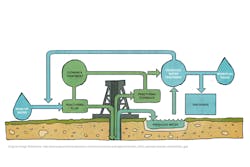To better understand the potential environmental impact of hydraulic fracturing, it is useful to understand the process itself.
Generally, hydraulic fracturing refers to a process of stimulating tight rock formations, often drilled a mile or more below the earth’s surface, to enable the release and extraction of crude oil and natural gas.
During the process of completing a new well through hydraulic fracturing, water is typically mixed with a proppant, usually sand, and chemicals, and the mixture, called fracturing fluid, is injected at high pressure through a wellhead to create small fractures (generally 1 millimeter or less) in the adjacent rock. The fluid opens the rock and carries the proppant. This keeps the fractures open, enabling the rock to release any oil or gas trapped inside and flow to the wellbore. Typically, the fracturing fluid is comprised of about 98 percent to 99.5 percent water, with the proppant and chemicals making up the remaining 0.5 percent to 2 percent.1
Often, the source water used to create the fracturing fluid must be filtered or treated before use to ensure unwanted salts and compounds do not interfere with the performance of the chemically enhanced fracturing fluid. For example, self-cleaning filters remove fine solids in the water to help protect high-pressure pumping equipment and reduce interference with fracturing fluid chemicals. Ultrafiltration membranes further reduce turbidity and provide virtually particle-free water to enable utilization of more advanced treatment, such as reverse osmosis desalination. Nanofiltration and ion exchange technologies help tailor the final water composition to meet the specific fracturing fluid requirements.
Once the hydraulic fracturing process is complete, some of the fracturing fluid – now called flowback water – must return to the surface to allow the well to produce. The flowback water typically contains not only the original fracturing fluid ingredients, but also hydrocarbons, minerals and other substances from the shale itself. In the early days of hydraulic fracturing, flowback water was often trucked away and disposed of in injection wells taking it back into the earth or collected in evaporation ponds. Increasingly, producers are recycling and treating flowback water before using it for the next hydraulic fracturing job or discharging it to the environment or nearest municipal wastewater treatment plant.
Flowback water treatment techniques and technologies vary depending on the quality of the produced water and various water quality standards, but they can include using self-cleaning fine particle filters to remove suspended solids and polymeric adsorbents for organic compound removal. Additionally, selective ion exchange resins and processes might be used to remove unwanted components, such as boron.
Longer term, the wells producing shale oil and gas will continue to produce water. Although the volumes of produced water are significantly smaller than water returning during flowback, the cumulative impact of produced water from many wells can be quite strong over time.
Snehal Desai is the global business director for Dow Water & Process Solutions. He is responsible for implementing the company’s business growth strategy and leading 1,700 people. Desai is an expert on industry and global issues such as water scarcity, quality and safety along with the interdependencies of water and energy.
Aaron M. Johnson is the growth technology leader for Dow Water & Process Solutions’ Oilfield Water platform. Since 2009, he has been responsible for establishing and leading programs to develop and commercialize solutions to water challenges facing the hydrocarbon exploration and production industry. His research efforts include new products, as well as application-driven research on membranes, ion exchange and specialty adsorbent technologies.
Resources
- Geology.com, www.geology.com/energy/hydraulic-fracturing-fluids/.


